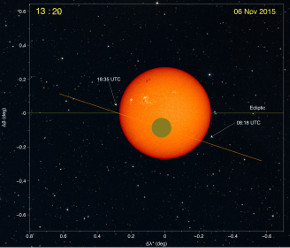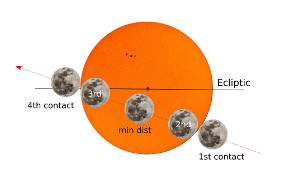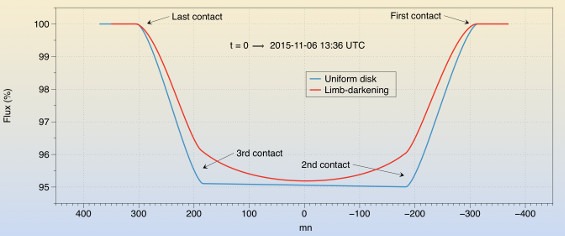Gaia's sensors scan a lunar transit
5 November 2015
Located 1.5 million km from the Earth, ESA's Gaia spacecraft is scanning the sky to conduct the most detailed census of stars in our Galaxy. However, on 6 November, it will be perfectly placed to witness a rare event that will involve objects much closer to home – a lunar transit across the Sun.Transits occur when planets move in front of a nearby star. Such events occur occasionally in our Solar System when we see Venus and Mercury pass across the Sun's brilliant disc. As the small worlds drift across the illuminated stellar disc they appear as dark dots or circles. They also block some of the light and heat emitted by the star.
 |
|
Gaia's perspective on the lunar transit. Image courtesy of F. Mignard, Observatoire de la Côte d'Azur, Nice |
The Moon sometimes covers the Sun – an event known as an eclipse - but we never see Earth's satellite as a small, dark circle crossing the face of the Sun. However, Gaia is far enough away to observe such a transit.
Although its sensitive optics must be pointed well away from the Sun and Moon, Gaia's temperature sensors (thermistors) will be able to detect a lunar transit that will not be visible to any human eye or other spacecraft.
For more than 10 hours on 6 November, a near perfect alignment between Gaia, the Moon and the Sun will enable the star mapping spacecraft to chart how its temperature changes during the transit.
In order to monitor its health and physical condition, thermistors monitor the temperature at many places in the Gaia spacecraft. A series of measurements is taken every minute and subsequently sent back to Earth. During the passage of the Moon in front of the Sun, the Gaia team expects to detect a noticeable drop in the spacecraft’s temperature.
 |
| Transit contacts. Image courtesy of F. Mignard, Observatoire de la Côte d'Azur, Nice |
During the first year of Gaia's science mission scientists have already seen small variations in the temperature data collected. The yearly change in solar distance due to the elliptical orbit of Gaia about the Sun results in a variation equivalent to ± 3.4% in the solar flux. This leads to a change of ± 1.2 °C in the temperature records.
Changes are also seen during the 6-hour spin period of Gaia. On the antenna, the temperature follows a very regular cyclical pattern, changing by 2 °C over each rotation-period.
The passage of 6 November 2015 will start at 08:18 UTC (GMT) with the first contact (outer contact) between the disc of the Moon and that of the Sun. The solar flux will gradually decrease for about 2 hours, until the Moon’s entire disc is visible in front of the Sun.
 |
| Predicted drop in flux during the lunar transit. Image courtesy of F. Mignard, Observatoire de la Côte d'Azur, Nice |
Over the next 6 hours the levels of incoming solar radiation will remain steady until the third contact. During the next two hours the Moon will move away from the solar disc and the event will end at 18:35 UTC.
The total duration of more than 10 hours equals 1.7 spin periods of the Gaia spacecraft. This should be enough to see a temperature drop of about 1.5 °C and to estimate the thermal inertia of the spacecraft’s components.
No temperature increase is expected to be measurable in the most insulated part of the spacecraft, but the Gaia team is looking forward to examining carefully the temperature records to see what really happened.
Gaia's orbit at L2, 1.5 million km from Earth in the anti-Sun direction, was aligned so that the number of lunar transits would be minimised and the spacecraft’s thermal environment would be as stable as possible. However, a similar celestial conjunction will occur in May 2016, and grazing transits, when only a fraction of the Moon’s disc will cover the Sun, are predicted for April 2016 and February 2019.
Contacts
Timo Prusti
Gaia Project Scientist
Email: timo.prusti![]() esa.int
esa.int
François Mignard
Observatoire de la Côte d'Azur, Nice, France
Email: francois.mignard![]() oca.eu
oca.eu
Sergei Klioner
Lohrmann Observatory, Dresden, Germany
Email: Sergei.Klioner![]() tu-dresden.de
tu-dresden.de




